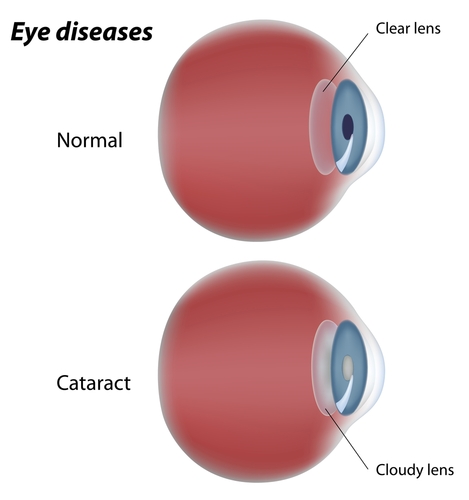June is Cataract Awareness Month. Cataracts are the leading cause of blindness in the world and affect more than 22 million Americans aged 40 and older. Bennett & Bloom Eye Centers wants you to be informed about the ways you can help protect yourself.
Risk factors for developing cataracts include diabetes, direct and prolonged exposure to UV radiation from sunlight, tobacco use and alcohol consumption. While half of all individuals 80 and older have cataracts, studies have shown that the risk for cataract development can be reduced by taking preventative measures in your younger years.
One easy step to prevent cataract development is to wear sunglasses, especially in the summer months when ultraviolet radiation from the sun is at its strongest. Studies have shown that UV radiation may cause the protein in your eye’s lens to breakdown, resulting in the formation of cataracts. Wearing sunglasses with UV protection will protect your eyes from excessive amounts of UV rays. When choosing a new pair of sunglasses be certain that they are 100 percent UV-absorbent.
Other preventable measures to take against cataracts include quitting smoking and consuming alcohol in moderations as both activities increase your chances of cataract formation. People who smoke at least 20 cigarettes per day have two times the risk of developing cataracts as compared to people who do not smoke. A 2010 Boston University study found that alcohol consumption of over 2 alcoholic drinks per day was linked to a significant increase in the likelihood of cataract development when compared to a total daily alcohol consumption of 1 to 2 drinks.
What are Cataracts?
A cataract is a clouding of the lens of the eye that affects a person’s vision. While cataracts are generally age-related, they can occur at birth due to a condition known as congenital cataracts.
Cataracts in adults develop slowly and painlessly. That’s why it is important to have your eyes examined on a regular basis as early diagnosis of cataracts is extremely helpful in maintaining good eye health.

Visual problems that may be associated with cataracts include:
- Being sensitive to glare
- Double vision
- Cloudy, fuzzy, foggy, or filmy vision
- Loss of color intensity
- Difficulty seeing at night or in dim light
- Seeing halo around lights
- Problems seeing shapes against a background of the difference between shades of colors
- Frequent changing of glasses prescriptions, or seeing better without glasses
- While it is possible to reduce your risk of developing cataracts, they are not 100% preventable. There are many different factors that can contribute to the development of cataracts including family history, medications, and age. A comprehensive eye exam can diagnose cataracts and help you and your doctor determine an effective plan for treatment.



